
|
Sale 61
Manuscript, Collectibles and Aerospace Auction
| Lot |
Photo |
Description |
Realized |
Lot 695 |
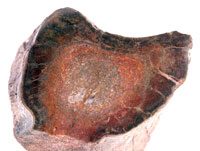 |
Agatized Dinosaur Bone. Agatized dinosaur bone occurs when the hollow bone structure of the dinosaur is replaced by quartz and trace minerals such as iron over millions of years. The best quality agatized dinosaur bone comes from the Jurassic era in Utah from the 150 million year old Morrison Formation. The vast majority of the dinosaur bone found is just broken fragments; rarely is an identifiable bone found such as this 5x4x6 inch sauropod tail vertebrae. The tail vertebrae is pretty much complete except for the neural spine process. Only the top of this rare dinosaur bone has been polished to reveal the bone structure. The individual cells in the center of the bone are distinct and range in color from white calcite to many shades of brown all the way up to orange. This impressive fossil stands on its own on the backside of the vertebrae.
Add $20 for domestic shipping.
Estimated Value $775 - 1,000.
View details and enlarged photo
| Unsold |
Lot 696 |
 |
Aquatic 150 Million Year Old Reptile. Sinohydrosaurus lingyuanensisgen was a strange looking aquatic reptile with a very long neck. It lived 150 million years ago in fresh water lakes in Liaoning Province, China. Sinohydrosaurus translates to Chinese water dragon. This juvenile specimen is over 4.5 inches long and virtually complete (missing only a few digits in the feet) with all four legs, tiny rib bones and even smaller gastralia rib bones and, most importantly, an excellently detailed skull. This superbly detailed reptile is excellently preserved in the same position that it was buried in 150 million years ago on a 5 x 4 inch matrix of soft tuffaceous volcanic rock. The tail is complete and curled in a defensive position which tells us that Sinohydrosaurus was able to move its tail in any direction and that the tail was not just stiff. Sinohydrosaurus may be an ancient relative of the fierce Komodo Dragon and complete museum quality specimens such as this one are becoming very difficult to locate.
Add $15 for domestic shipping.
Estimated Value $450 - 550.
View details and enlarged photo
| Unsold |
Lot 697 |
 |
Brontotherium Jaw With Three Teeth. Brontotherium was an enormous extinct North American mammal that looked like a rhino but was closer related to a horse. These enormous mammals stood 8 feet tall at the shoulders and had an odd-shaped, blunt, bony protrusion on its nose. Native Americans of the Sioux tribe found bones from these enormous beasts and called them thunder horses because they believed that they produced thunderstorms when running over clouds. This large 14 inch long lower jaw is massive, with three large molars, the largest being 4 inches long. Brontotherium has an very distinctive W shape on the top of their molars, which meant that they probably ate soft stems and leaves rather than tough vegetation. The teeth are a brownish-gray color, nicely contrasted against the cream-colored bone. This 35-40 million year old fossil was found in South Dakota and comes with a display stand.
Add $35 for domestic shipping.
Estimated Value $900 - 1,200.
View details and enlarged photo
| Unsold |
Lot 698 |
 |
Carcharodon Megalodon Shark�s Tooth. Even though Carcharodon megalodon was the largest shark that ever lived, growing to more than 50 feet in length, most of the teeth found are only 3-4 inches in length. Teeth over 5 inches in length are in great demand and a full 6 inches is the size that every collector aspires to own. This immense 6 inch 15 million year old Carcharodon tooth was found in the muddy river waters of South Carolina. Estimating the length of a shark at about 10 feet in length to every one inch of tooth, this behemoth would be 60 feet long. This huge tooth has fairly complete enamel on both the front and back except for a two-inch section right in the center. The edge is average without any serrations. It is the color that makes this tooth special, being taupe with some flecks of orange on the front enamel which contrasts nicely with the black root. This is an opportunity to purchase a really huge 6 inch and colorful megalodon tooth without paying well over $1000.
Add $15 for domestic shipping.
Estimated Value $500 - 750.
View details and enlarged photo
| Realized
$529 |
Lot 699 |
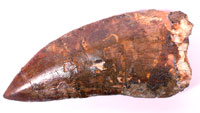 |
Carcharodontosaurus Dinosaur Tooth. Huge 4.12 inch long by 1.75 inch wide complete dinosaur tooth of Carcharodontosaurus saharicus, the T-Rex of Africa. Even though Carcharodontosaurus was even larger that a T-Rex, most of the teeth found are only 1.5 to 2.5 inches long. This excellent brown tooth was found in two pieces which fit together exactly with only minor repair to the very end of the tip. It is not only long and wide but also has most of its enamel present with only minor enamel chipping which almost always occurs. The steak knife-like serrations are sharp and present on both edges of the tooth with only minor breaks. This very large impressive tooth was found in the Sahara desert of Morocco. Carcharodontosaurus was older than a T-Rex at 70-80 million years old and is an excellent value for a huge carnivorous dinosaur tooth. A T-Rex tooth this size would cost more than $5,000. Housed in an 8 x 6 inch Riker mount.
Add $15 for domestic shipping.
Estimated Value $800 - 1,200.
View details and enlarged photo
| Unsold |
Lot 700 |
 |
Cave Bear Lower Leg and Foot. This extremely large 12.5 inch long foot and 10 inch long Tibia with Patella belongs to the famous Cave Bear (Ursus spelaeus) that lived 50,000-100,000 years ago in the caves of Romania. The bone quality is excellent with claws over 1.75 inches. This leg and foot are from an extremely large Cave Bear as most feet are 10-11 inches long. Mounted on a black board with the foot bones wired together and the tibia removable.
Add $25 for domestic shipping.
Estimated Value $750 - 950.
View details and enlarged photo
| Unsold |
Lot 701 |
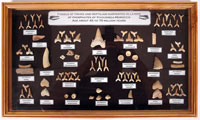 |
Collection of Fossilized Shark, Fish and Mosasaurs. This collection of over 85 Shark, Stingray, fish and mosasaur teeth come from the Moroccan Phosphate mines of Khouribga. There are 25 different species in this collection that are mounted and labeled as to species in a custom wooden case that is 19.25 x 11.5 inches. These complete fossil teeth are between 45-70 million years old and range in size between .5 inch to 2 inches. This is an important collection revealing the diversity of sea creatures in the warm seas of ancient Morocco with a wide variety of different shaped teeth and species.
Add $30 for domestic shipping.
Estimated Value $375 - 500.
View details and enlarged photo
| Realized
$423 |
Lot 702 |
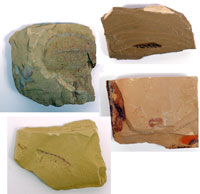 |
Collection of the Very First Cambrian Animals. The 525 million year old fossils of Chengjiang are very important as being the earliest and best preserved of the early Cambrian fossils: they are 15 million years older than the famous Burgess Shale of Canada. Many types of small, weird, soft-bodied animals are found at Chengjiang and this collection contains four of the most famous. Haikouella was one of the earliest chordates, which are the earliest ancestors of the vertebrates. This small swimming animal was only about one inch long but had a head, gills, brain, notochord, heart and circulatory system and perhaps even small eyes. This specimen is 20mm long and shows the gill slits which covered most of their body. Naraoia, a trilobitomorph, is represented by a virtually complete 7mm long specimen that clearly shows its two-body shield sections which separates it from trilobites which had three sections. Anomalocaris was the top predator of the early Cambrian and grew to over three feet in length, but usually only the feeding appendages are found because they were the only part of its body that was scelotized (strengthened). This 16mm appendage is typical in looking like a shrimp with legs, which is what early paleontologists thought it was. Last is a near complete specimen of the bivalve shell (50 x 35mm) of Tuxioa, which was a strange looking arthropod with its entire body, except for its antennae and tail, covered with an ornamented bivalve shell. This unusual grouping is a rare opportunity to study multiple fossils from the earliest site of the Cambrian explosion. Housed in a 12 x 8 inch Riker mount for display.
Add $20 for domestic shipping.
Estimated Value $600 - 800.
View details and enlarged photo
| Realized
$570 |
Lot 703 |
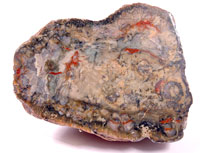 |
Colorful Dinosaur Coprolite. This colorful and interesting fossil comes from the business end of a 150 million year old plant eating dinosaur. Coprolites are fossilized dung that can give us information about what dinosaurs ate, as well as bone fragments from carnivorous dinosaurs and plant material from herbivorous dinos. This very large 7 x 5.5 inch over 7 pound coprolite has the classic pebbly exterior surface and one side has been cut and polished to show its colorful interior which at first glance looks like a piece of petrified wood. The colors of reds, grays, and various shades of creams and browns represent mineral displacement of the organic material over many millions of years. This fossil is much larger more and colorful than most coprolites found in the Morrison Formation of Montana and represents a very large dinosaur such as a Stegosaurus or a sauropod. A somewhat larger but less colorful coprolite recently brought $6,000 at auction.
Add $20 for domestic shipping.
Estimated Value $350 - 450.
View details and enlarged photo
| Unsold |
Lot 704 |
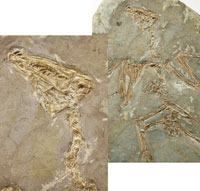 |
Complete Dromaeosaur Dinosaur. Dromaeosaurs were the most bird-like of all theropod dinosaurs; their bodies were covered in feathers. Dromaeosaurs, such as the famous Veloceraptor, had a large skull with sharp serrated teeth, long arms and large hands with three long fingers, three toed feet and a long stiffened tail. At least some Dromaeosaurs had bird-like pennaceous feathers on their arms and tails and short down-like feathers covering their body. Most Dromaeosaurs were small to medium-sized dinosaurs 2-15 feet long. This rare, bird-like Dromaeosuar is 125 million years old and was found in a dry lake bed in Central Asia. It is 30 inches long on a 29 x 18 inch stone matrix. The body is 13 inches long and the long, stiffened tail is 17 inches long. Interestingly, the arms and legs are the same length--11 inches long-- which is much different from most dinosaurs which have much longer legs than arms. This Dromaeosaur appears to be a very primitive one in that the second claw on its feet is not much longer than the other two claws. With most Dromaeosaurs, the second toe had a larger killing claw and was held off of the ground. One of the feet has all three claws and the other foot has two claws. Both of the long arms have only one claw preserved. The all-important skull is quite large-- 3 x 2 inches--and virtually complete with 16 sharp teeth, some of which are disarticulated in the skull. This dinosaur is mostly complete and probably a composite of two or more partial dinosaurs that were put together to form one excellent complete specimen.
All of the dinosaurs found in the soft volcanic ash that turned to rock at the bottom of a lake bed are found disarticulated and in many dozens of pieces. It is somewhat like putting together a puzzle to get a complete dinosaur from all of the pieces. Dromaeosaurs had hollow light bones like birds, which can be seen from this specimen in that many of the bones have been cracked and compressed in the burial process. This is indeed a rare opportunity to own a very rare theropod dinosaur that has only about 10-15 percent restoration and whose looks confirm the theory that birds are dinosaur. This Dromaeosaur would have had feathers even though no feathers are preserved on this specimen. This dramatic fossil comes with a metal display stand to make it the featured fossil in any collection.
Add $100 for domestic shipping.
Estimated Value $10,000 - 15,000.
View details and enlarged photo
| Unsold |
Lot 705 |
 |
Crocodyliform Reptile Skull. Dryosaurus phosphaticus was a huge 15-25 foot long marine reptile that somewhat resembled a marine crocodile but with a longer and more narrow snout. This large 20 inch long skull is 45-70 million years old and was found in the phosphate mines of Khourigba, Morocco. Shark�s teeth are fairly common from this location but reptile skulls are not. This spectacular skull is a creamy white color on a brown sandstone base. There are six .5 inch long sharp teeth on one side of the jaw. The skull is unusually slender tapering down from 8 inches wide hear to a 2 inch wide snout with its two nostrils visible at the tip. The lower jaw is missing but the skull rests flat on its limestone base for a dramatic display.
Add $25 for domestic shipping.
Estimated Value $400 - 550.
View details and enlarged photo
| Realized
$470 |
Lot 706 |
 |
Dinosaur Egg Museum Quality. This prepped complete fully inflated unhatched Duckbill dinosaur egg is 70-80 million years old, 7 x 6 inches and of museum quality, with over 90 percent of its original shell intact. The egg is completely original and has been professionally airbrushed to remove all of the minerals covering the original shell, leaving the shell exposed with its deep chocolate brown color. We do not know what Duckbill species this egg belongs to, but being the largest Duckbill egg at a gigantic 7 inches in length (most eggs being 5-5.5 inches long), it might belong to the huge Duckbill dinosaur Shantungosaurus which reached more than 50 feet in length and has been found in the same area in the Henan Province of China. This museum quality dino egg makes an excellent display, having much more original egg shell than is normally found and still standing on a small section of its reddish brown limestone matrix.
Add $25 for domestic shipping.
Estimated Value $700 - 1,000.
View details and enlarged photo
| Realized
$617 |
Lot 707 |
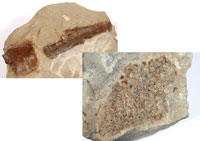 |
Dinosaur Skin With Leg Bone. Dinosaur skin is the rarest and most coveted of dinosaur fossils because of its extreme rarity, being preserved only under extraordinary conditions. The dinosaur had to have been completely covered by fine mud sediments probably in a large river delta within a day or so after dying to avoid bacterial breakdown of the skin and soft tissue which would occur immediately. This type of extreme condition may have occurred in a massive flood. The skin texture was impressed in detail in the soft clay forming a natural mold which was later filled by more muddy sand creating a natural cast and remained intact for over 65 million years even after the skin and other soft tissue was destroyed by bacteria. This pair of large 6 x 3 inch sections of both the positive and negative parts of rare dinosaur skin is from an Edmontosaurus duckbilled dinosaur and is between 65-70 million years old. It was found, along with a partial femur leg bone of a Edmontosaurus, in the Hell Creek Formation of Montana. The skin shows the irregular shaped scales that formed their tough skin. What makes this piece unique is that the large 13X x 2 inch matrix containing the partial femur was split to reveal the skin impressions while still preserving the dark colored bone on the matrix as well as a large 9X6 inch section of dark brown bone from the femur head on the opposite side of the stone block from the lighter skin impression. This is a rare occurrence as a skin impression is rarely found connected to actual bone. Also, as a bonus, on the other side of the matrix is a tail vertebrae still embedded in the matrix. The slightly disarticulated 2.5 x 3.2 inch vertebrae has its 7 inch long vertical process just next to it. The vertical bone section would have connected the vertebrae to the large strong tail muscle. This lot contains both sections of bone and skin impressions. This is a rare heavy dinosaur bone assemblage for study and display.
Add $75 for domestic shipping.
Estimated Value $1,250 - 1,550.
View details and enlarged photo
| Unsold |
Lot 708 |
 |
Fascinating Spiny Trilobites Morocco. There are many different varieties of spiny trilobites found in Jjebel, Issoumour Morocco more than 375 million years age. There must have been an arms race going on with the trilobites developing sharp spines to protect themselves from being swallowed whole by carnivorous worms and other predatory sea creatures that did not have teeth. Toothed fish did not exist at this time, only jawless fish. These trilobites are very spectacular and require many hours of tedious work to reveal the delicate spines. This gives them an amazing life-like appearance compared to the usual quality where the spines are flattened or missing entirely.
This pair of complete Cyphaspis are certainly bizarre with two horns jutting from their head, short eye stalks and long sharp genal spines protecting their bodies. Dramatically positioned on a 3.5 x 2 inch grey matrix, the largest specimen is 1.4 inches long and the smaller one 1 inch long. Just a single specimen of Cyphaspis brought over $800 in a recent auction.
Add $20 for domestic shipping.
Estimated Value $700 - 1,000.
View details and enlarged photo
| Unsold |
Lot 709 |
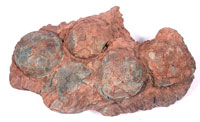 |
Five Therizinosaur Dinosaur Eggs. This original partial nest of five dinosaur eggs is very distinctive in being from the rare and poorly understood class of dinosaurs known as Therizinosaurs. Therizinosaurs were some of the strangest looking dinosaurs, having some features of a plant eating dinosaur and some features of a theropod dinosaur. They had a small skull on a long neck with a large gut which resembled a plant eating dinosaur, but also were bipedal, had filamentous feathers, and extremely large hand claws like a theropod dinosaur. Embryos have been found in some of the eggs of this shape so we know that they belong to this strange dinosaur which probably was a plant eating dinosaur, although some paleontologists think that the large claws may have been used to tear apart large termite mounds.
The five eggs are 3 x 3 inches long and are still contained in their original 11 x 7 inch red limestone matrix as deposited between 80-90 million years ago in the Xixia Basin of the Henan Province, China. The eggs are in excellent condition, being unhatched, varying between completely inflated to one egg that is mostly flattened. Even though the shells of Therizinosaur eggs are very thin, these eggs contain between 60-100 percent of their original shell.as found; a lot of the shell is still beneath a thin layer of red calcite. Even the egg with about 60% shell appears to have more shell beneath the stone matrix. Therizinosaur dinosaur eggs are in great demand and much rarer than the usual Hadrosaur and even the Oviraptor dinosaur eggs.
Add $50 for domestic ahipping.
Estimated Value $1,600 - 2,200.
View details and enlarged photo
| Unsold |
Lot 710 |
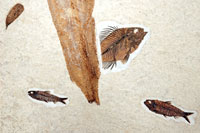 |
Green River Fish and Leaves. Green River Wyoming is famous for its exquisitely fossilized 50 million year old fish and leaves. These are usually found separately because most of the fish are found in deeper water than the plants which are mostly found close to the ancient lake shore. Rarely are they found together as on this 15.5 x 10 inch limestone plate. This plate contains a large 8 inch section of a banana leaf and a smaller 2 inch leaf. The three fish consist of a partial excellently preserved 3.75 inch long Prixcacara with sharp dorsal spines swimming out from behind the banana leaf as well as two Knightias 3 inch and 2.5 inch with excellent fins. The medium to dark brown fossils are nicely contrasted against the cream colored limestone matrix.
Add $25 for domestic shipping.
Estimated Value $550 - 700.
View details and enlarged photo
| Unsold |
Lot 711 |
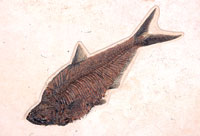 |
Huge 17 Inch Fish. Some of the best preserved fish in the fossil record are found in the 50-52 million year old Green River Wyoming fossil fresh water lake beds. The vast majority of the fish found are small, measuring only 2-4 inches long. This museum quality lot is the exception with a huge 17 inch long (close to the maximum size) Diplomystus which was an extinct member of the herring family. The huge fish is complete with outstanding skin, fins and skull with sharp little teeth in its distinctive upturned mouth, which enabled it to feed on small fish and creatures near the surface of the lake. The upper jaw is slightly disarticulated, which makes it look even more fearsome. The ends of some of the tiny fine ventral spines have been restored. The dark brown fish is nicely contrasted on the cream colored 26 x 18 inch sandstone matrix and has been backed with wood for stability.
Add $35 for domestic shipping.
Estimated Value $800 - 1,000.
View details and enlarged photo
| Unsold |
Lot 712 |
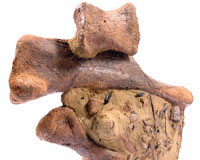 |
Huge Trio of Dinosaur Bones. This huge 22 x 17.5 x 5 inch natural sandstone block contains many bones and teeth of the famous duckbilled dinosaur Edmontosaurus annectens. Edmontosaurus was a favorite food choice for a T-Rex and lived in herds. This well-preserved collage of bones resulted from the dinosaur being quickly buried under mud in a river or stream and remaining undisturbed for 66-67 million years until being found on a private ranch in the Lance Creek Formation of Niobrara County, Wyoming many years ago. The museum quality slab consists of a huge, complete 22 inch long humerus arm bone and 7 inch long tarsal and 8 inch long metatarsal foot bones. In addition, there are over six teeth up to one inch long and many fragmented strut bones. The bone quality of the three main bones is outstanding, with just a few minor cracks filled on the humerus. The large humerus and tarsal bones have a complete 3D look, being visible both front and back, just being connected to the matrix on their bottom sides. Most of the matrix has been expertly removed, with the entire display being only 5 inches wide and standing on its own with a flat bottom.
Add $70 for domestic shipping.
Estimated Value $2,500 - 3,000.
View details and enlarged photo
| Unsold |
Lot 713 |
 |
Mammal Hyena Ictitherium Skull. This excellent, complete 26 million year old fearsome mammal skull belonged to one of the earliest types of Hyenas that looked vastly different from the Hyenas that exist today. Hyena ictitherium lived in eastern Asia and looked something like a Civet with a long, four-foot body and short, powerful legs. Their massive skulls, with sharp, over one-inch-long canines, clearly show that they were carnivorous and likely hunted in packs. This museum quality skull was prepared out of the original matrix, with some of the matrix still inside of the skull. The skull measures 8.5 x 5 inches and is virtually complete; there are some cracks in the skull but all of the teeth are present, although some of the teeth have been placed back into position on the skull. This rare and impressive skull has been mounted on a 6 x 6 inch custom black Lucite stand, making for a very impressive display.
Add $40 for domestic shipping.
Estimated Value $1,600 - 2,000.
View details and enlarged photo
| Unsold |
Lot 714 |
 |
Megalodon Shark Evolution. Unlike dinosaurs, tracing shark evolution is very difficult since only teeth are preserved with little other remains The geneology of the largest shark known (over 60 feet) Carcharocles megalodon can be traced back 50 million years to Otodus obliquus of Morocco. This interesting lot of four different shark�s species has complete teeth of each of them to illustrate the change in the teeth, not just in size but also in serrations, and the loss of the secondary side cusps (cusplets). The approximate size of a shark can be estimated from the size of its teeth, ten feet in length for each one inch of tooth. The teeth are measured on their longest diagonal.
1. Otodus obliquus 3 inches long without serrations and two prominent side cusps. This 30 foot long 50 million year old shark was found in the phosphate mines of Morocco.
2. Carcharocles angustidens 3 inches long with serrations and two prominent side cusps and the tooth is getting wider. This 30 foot long 15-20 million year old shark was found in the rivers of South Carolina.
3. Carcharocles chubutensis 2.5 inches long with sharp serrations and two very small side cusps. This 25 foot long 12-20 million year old shark was found in the rivers of South Carolina.
4. Carcharocles megalodon 4.25 inch long with sharp serrations and no side cusps and much wider. This monster 43 foot long 8-15 million year old shark was found in the rivers of South Carolina.
An interesting group of fossil shark�s teeth for both study and display.
Add $20 for domestic shipping.
Estimated Value $500 - 700.
View details and enlarged photo
| Unsold |
Lot 715 |
 |
Moroccanites Spiny Trilobite. Trilobites were one of the most successful groups of arthropods proliferating in the oceans of the world from 535-325 million years ago and probably were so successful because they were one of the very first animals to have eyes. They had hard exoskeletons and were closely related to the existing living fossil horseshoe crabs.
The spiny trilobites are certainly among the most interesting and odd looking shapes that trilobites took. This 375 million year old spiny trilobite Moroccanites comes from the Kjebel Issoumour area of Morocco. This extraordinary 3 inch black trilobite has been expertly prepared using a micro sand blaster to reveal all of its amazing 3-D detail, including all of its segments, defining long snout-like spine, multiple lense compound eyes and even its mouth (hypostome). The trilobite looks alive perched on its 3.25 x 2.75 inch grey stone matrix.
Add $15 for domestic shipping.
Estimated Value $450 - 650.
View details and enlarged photo
| Unsold |
Lot 716 |
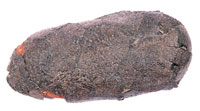 |
Museum Quality Oviraptor Egg. This original unhatched Oviraptor egg is 70-80 million years old, from the Djadokhta formation of Ukhaa Tolgod of Mongolia. It was found in the Gobi desert and is just over 6.5 inches long, belonging to the largest of the two Oviraptor species called Citipati to distinguish this difference from the other smaller species. Citipati Oviraptorids were made famous by the nest of eggs with the mother Citipati sitting on top of the eggs in a brooding position. This famous specimen is displayed in the New York Museum of Natural History and was discovered in 1995. It was revolutionary to discover a dinosaur sitting on top of its eggs like a bird and only later was it discovered that Oviraptors such as Citipati also had feathers like a bird. Citipati eggs are ratite in texture and have a very thin shell, which is why they are rarely found complete. This premium quality egg is slightly compressed from being buried under layers of rock and has sharp textured detail on the shell, with over 90% original shell and has been fully airbrushed resulting in a highly detailed dark brown shell. Because of their thin shells most Oviraptor eggs have less than 50% original shell. Superb museum quality unhatched eggs such as this one are extremely hard to locate.
Add $20 for domestic shipping.
Estimated Value $900 - 1,200.
View details and enlarged photo
| Unsold |
Lot 717 |
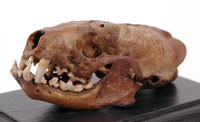 |
Mustelid From Michigan Bog. Mustelids were weasel type animals similar to minks and ermines. This three inch long 5,000-8,000 year old brown skull is complete and was found in a Bog deposit in Saginaw county, Michigan. All of the teeth are present and nicely contrasted against the light brown skull. Of special interest is the upper molar in the back of the mouth that is rotated 90 degrees towards the inside of the mouth. This enabled the mustelids to tear off meat from prey animals even if they were frozen solid. Only mustelids have such a special upper molar. The skull has a beautiful brown color from the minerals in the bog somewhat similar to the animals found in tar pits. This interesting skull comes with a 4 x 3 inch black base for display.
Add $25 for domestic shipping.
Estimated Value $225 - 375.
View details and enlarged photo
| Realized
$188 |
Lot 718 |
 |
Pair of Dinosaur Footprints. This pair of rare fossil dinosaur footprints on a 11 x 6 inch gray shale slab contains two Grallator cuneatus footprints, a complete 5.75 inch footprint and a larger 6 inch footprint missing one of the toes. These 187-208 million year old footprints from the East Berling formation of West Springfield Massachusetts were made by meat-eating dinosaurs similar to Podokesaurus, a medium sized theropod, whose partial skeleton was found in the same area. These footprints are the more highly valued negative raised impressions which preserve the most detail of the dinosaur stepping in soft mud preserving some pad and claw details. This rare pair of dinosaur prints probably represents two different Grallator dinosaurs traveling together as the prints are so close together.
Add $15 for domestic shipping.
Estimated Value $350 - 450.
View details and enlarged photo
| Unsold |
Lot 719 |
 |
Partial Dinosaur Foot. This partial foot belongs to 8 to 13 foot long herbivorous dinosaur that weighed between 450-650 pounds, named Thescelosaurus. Thescelosaurus was one of the very last dinosaurs alive at the end of the Cretaceous. It was bipedal with a four toed foot. What makes this lot interesting is that all of the bones were found in the same dig in the 67 million year old Hell Creek Formation of Montana and belong to the same dinosaur, not a composite. The partial foot consists of parts of all four claws and 6 of the toe phalanges. All four claws would be about one inch long with two of the claws virtually complete except for the ends of the tips and the other two being partials. One toe is four inches long and complete with the best claw and three complete phalanges. The other three phalanges are partial. Thescelosaurus was a hypsilophodont dinosaur that is famous for the excellently preserved specimen found in 1993 in South Dakota that had a well preserved heart. Preserved in a 8 x 6.5 inch Riker Mount.
Add $20 for domestic shipping.
Estimated Value $900 - 1,200.
View details and enlarged photo
| Unsold |
Lot 720 |
 |
Petrified Rainbow Colored Wood. This huge 22 x 18 inch agatized and polished complete section of petrified wood from the Araucarioxylon tree has a wonderful mix of rainbow colors that resulted from many different minerals permeating the wood at different times from the volcanic soil over millions of years. The unusual orange and red colors were produced by replacement by iron oxide. This exceptionally large section has the most colors imaginable on one fossilized tree with reds, burnt orange, hues of browns, lavender, beiges, white crystals, blue and even a mustard color. Pictures definitely do not do justice to this huge museum quality specimen. Araucarioxylon arizonicum is an extinct 225 million conifer tree that is the state fossil of Arizona and known to all visitors to the Painted Forest National Park.
Add $45 for domestic shipping.
Estimated Value $1,200 - 1,600.
View details and enlarged photo
| Realized
$969 |
Lot 721 |
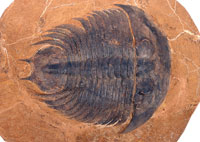 |
Rare Giant Trilobite. Large trilobites are highly value by collectors as there are only a very small number of species that grow to large size, most trilobites being only 1-3 inches long. Dikelokephalona is over 475 million years old from Morocco and is not only rare but also big and impressive. This complete trilobite is 9.75 x 8.5 inches on a 14 x 12 inch long stone matrix. Dikelokephalona differs from the over 100 times more common Paradoxites by having an unusual pair of tail spines on its pygidium as well as being much wider. The quality of this specimen is much above average with a well defined pair of eyes and excellent detail on all of the body segments. A rare, large and impressive trilobite.
Add $40 for domestic shipping.
Estimated Value $550 - 750.
View details and enlarged photo
| Unsold |
Lot 722 |
 |
Spinosaurus Foot Claw and Huge Tooth. Made famous in "Jurassic Park III" as the dinosaur that killed a T-Rex, the enormous theropod dinosaur Spinosaurus with a huge sail on its back remains an enimagmatic dinosaur as no skeleton even remotely complete has been found and the only partial skeleton was destroyed in World War II. Spinosaurus is mostly known from its teeth which are fairly common but usually broken and ugly. This huge 4.75 inch tooth is the exception being a lovely brown color with over two inches of light colored root with just some minor repairs to a couple of cracks in the enamel and some natural feeding wear from use when the dinosaur was alive. Claws are much rarer than teeth because the dinosaur could replace its teeth but not the claws. This 80 million year old dinosaur foot claw is 3.5 inches long with even the delicate tip complete and just a couple of minor cracks expertly filled. Both of these rare dinosaur fossils were found in the Kem Kem Valley near Taouz, Morocco (near the border with Algeria). Thee museum quality fossils are housed in an 8 x 6 inch Riker mount, along with a realistic picture of what a living Spinosaur might have looked like.
Add $20 for domestic shipping.
Estimated Value $750 - 1,150.
View details and enlarged photo
| Unsold |
Lot 723 |
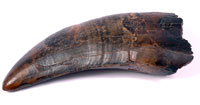 |
T-Rex Tooth Huge 3.25 Inches. This 3.25 inch long T-Rex tooth is not only large but also pristine with an excellent tip, serrations and no repair. There are a few serrations missing but the all important tip is completely intact with no feeding wear, which is very rare as most T-Rex teeth even found intact have feeding wear on their tips; these occurred while the T-Rex was still alive. Only a few cracks have been filled, as is usual for all T-Rex teeth found. The tooth is rather thick, has sharp squared serrations which define it as a T-Rex, and even shows a slight indentation at the root level on one side which is from a replacement tooth that was already growing behind this tooth when it was broken off when the T-Rex was feeding. All T-Rex teeth are shed teeth except the very few that are found with the dozen or so partial skeletons that have been found. This impressive and rare tooth was found in an ancient river or lake bed on a private ranch in the 65-67 million year old Hell Creek Formation of Montana. All T-Rex teeth are in great demand, but those very few that are not broken and repaired with pristine tips are rarely encountered.
Add $20 for domestic shipping.
Estimated Value $4,000 - 5,000.
View details and enlarged photo
| Unsold |
Lot 724 |
 |
Trio of Unhatched Oviraptor Eggs. This original trio of complete Oviraptor eggs is 70-80 million years old from the Djadokhta formation of Ukhaa Tolgod of Mongolia. These eggs were found in the Gobi desert, are 6.5 inches long and belong to the largest of the two Oviraptor species called Citipati to distinguish this difference from the other smaller species. Citipati Oviraptorids were made famous by the nest of eggs with the mother Citipati sitting on top in a brooding position. This famous specimen is displayed in the New York Museum of Natural History and was discovered in 1995. It was revolutionary to discover a dinosaur sitting on top of its eggs like a bird and only later was it discovered that Oviraptors such as Citipati also had feathers like a bird. Citipati eggs are ratite in texture and have a very thin shell, which is why they are rarely found complete. This high quality trio of eggs has nice textured detail on the shell and about 80-90%. The shell is a light gray color, which nicely contrasts the 14 x 7 inch red limestone matrix. The eggs are completely original as found, with the shell still having some light matrix on them in places. Oviraptor eggs and indeed all dinosaur eggs are in great demand, as the only available eggs come from collections.
Add $40 for domestic shipping.
Estimated Value $1,500 - 2,000.
View details and enlarged photo
| Unsold |
Lot 725 |
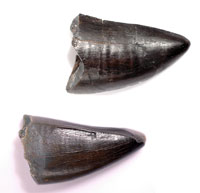 |
Two T-Rex Teeth. Virtually all T-Rex teeth found are shed teeth that broke off when the T-Rex was feeding on some other dinosaur. Usually these teeth are just fragments or are broken into many pieces, but this lot consists of two virtually complete shed T-Rex teeth without the root that were found within a few feet of each other in the 66-67 million year old Lance Creek formation of Wyoming. There is no restoration to either tooth. The larger 1.75 inch thick tooth has excellent enamel and sharp, nearly complete serrations with a perfect, intact tip. The other tooth is a 1 inch long Pre-maxilary tooth from the very front of the mouth and has excellent enamel with some wear on the enamel at the tip that occurred when the T-Rex was still alive and some serrations, but they are not sharp. The Pre-maxialry teeth are very distinctive in having two rows of serrations close together on the inner curve of the tooth versus having one row of serrations on the opposite sides of the regular teeth. This set of the two different types of T-Rex teeth may be from the same juvenile T-Rex with superb dark brown color and are displayed in a 5.5x4.5 inch Riker Mount.
Add $25 for domestic shipping.
Estimated Value $2,250 - 2,750.
View details and enlarged photo
| Unsold |
Lot 726 |
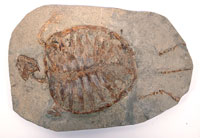 |
Virtually Complete Turtle. Turtles are unique in the animal world, having their entire torso embedded in a bony shell casing. There still is no consensus about their origins. Turtle fossils are usually just the carapace without the head and limbs. This 125 million year old fossil 9.5 x 5 inch Mancherochelys sp. from Liaoning, China is the rare exception, having an excellent skull and parts of all four limbs and tail. This turtle has been fossilized in the ventral position with its webbed plastron sitting inside its carapace. The medium brown color is nicely contrasted against the lighter 10 x 7 inch stone matrix. Mancherochelys was a Crytodira turtle that could not withdraw its head and limbs inside like modern turtles. A rare, spectacular,and well detailed fossil turtle.
Add $20 for domestic shipping.
Estimated Value $2,500 - 3,000.
View details and enlarged photo
| Unsold |
|
|